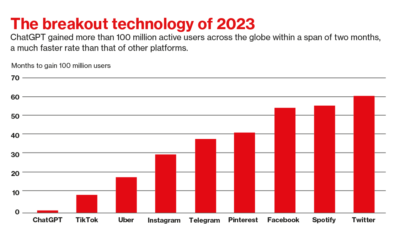Politics
How Generative AI is Changing the Way Creatives Work
Published
8 months agoon
By
Drew Simpson
Over the past year, we have seen an explosion in the use of artificial intelligence, or AI, across multiple industries. With all of the advantages that AI has to offer, there is no denying that it is truly transforming the way creatives work. Artificial intelligence has enabled new ways of creating art and copy while freeing professional creatives from mundane or repetitive tasks. It’s also motivating some creatives to reimagine work — reframing challenges through the lens of new AI capabilities and rethinking procedures in current creative processes.
The spotlight on generative AI is only getting brighter, but this new technology poses considerable questions for designers whose primary role is based on creative, compelling visuals.
Will creatives need generative AI to succeed in the future? What sort of prompting will elicit the best generative AI output? Does generative AI even need designers to become and stay meaningful?
AI Disrupting Conventional Methods
Creativity has long been viewed as a uniquely human quality, forging new ways of thinking, unlocking new patterns, and using empathy. With applications like ChatGPT enabling rapid content creation and Midjourney driving an explosion of AI-generated art and images, many worry that human’s claim to creativity may become a thing of the past. In the time since these technologies flooded the market, we are already seeing changes in how people create audio, text, and even written content. The reaction to generative AI is mixed.
Generative AI in Non-Creative Roles
For those outside of traditionally creative professions, generative AI has significantly lowered the barrier to entry for writing, designing, and crossing the boundaries of their creativity. That said, most agree that creative output through AI tools lacks the emotional aspect of content produced by humans and only benefits from human involvement.
Artificial intelligence has wholly disrupted art and copy alike in the content-creation economy.
For individuals who work in content-creation roles — such as copywriters, designers, UX experts, or marketing communications professionals — the introduction of generated AI into creative processes has helped to increase the volume of written content, idea generation, and visual output.
How Generative AI is Changing Creative Work
When it comes to generative AI and creativity, there are several ways that individuals and industries of all sizes are taking advantage of this transformational tool. We see countless businesses utilize artificial intelligence to own and accelerate the end-to-end process. Generative AI is expanding how we create by empowering businesses, from ideas to tests to personalization for every customer.
Artificial intelligence has eliminated some technical constraints for those with more ideas than resources, allowing creatives to design and execute complete experiments without relying on an entire team to accomplish them. As more individuals turn to artificial intelligence, we will continue to see a rapid iteration in creativity.
The Benefits of Generative AI and Creativity
1. Increased productivity: Artificial intelligence allows creators to increase the number of images and words created instantly. Many individuals utilize this technology at all content-creation stages, from start to finish.
2. Overcoming creative blocks: Many find that artificial intelligence enables them to fill in the gaps when creating alternative product versions. AI effectively allows creatives to overcome production bottlenecks and combat unavailable resources with little effort.
3. More sophisticated options: Given the speed of artificial intelligence, creatives can generate words, content, and even code at a much higher volume. This gives them many different ways to create art in the digital space.
4. Idea generation: We’ve all experienced brain fog or struggles while brainstorming ideas for content. With artistic creativity in artificial intelligence, AI can provide creatives with various ideas for any project, allowing professionals to work more efficiently.
5. Automation: Through pattern-driven design — such as subject lines, header image creation, old images, meta descriptions, and even module designs — we can expect some sense of automation moving forward.
Generative AI will continue to actively learn from prompts and inputs, evolving through increased use from those committed to understanding how to work with AI models and derive value from AI. Regarding the future of creative work, we expect artificial intelligence to enhance, rather than replace, human-generated content.
What to Watch For
In the short term, how creatives interact with AI models will also change. By refining our interactions, creatives will steer AI models to produce more consistent, desired outcomes that meet brand standards, achieve communication goals, and cater to specific challenges and business needs.
We’ll evolve from simply generating more art and copy to creating valuable, usable assets. You only need a creative mind, access to AI tools, and an openness to exploring AI to get there.
Very soon after, how we frame and phrase problems and challenges to AI will become more critical than prompting. As AI learns, it becomes more intuitive and adept at understanding natural language. Problem formulation — the ability to identify, analyze, and describe problems — will move the forefront of interactions with AI. And this should feel familiar: We no longer need to put search terms in parentheses or use keywords to surface relevant content on the internet.
The Future and Beyond
Finally, digital asset management may become challenging due to the significant increase in digital assets created by artificial intelligence and limited documentation around ownership since it’s so new. Plan on discussing the governance and maintenance of content if you’re starting to use generative AI at work. You’ll want to think through content ownership and attribution, storage, and licensing terms (similar to rights-managed content). Work with your legal team so they can develop a point of view and terms of service, especially if you’re at an agency doing work on behalf of a client.
Artificial intelligence allows you to make more personalized and relevant content, which can benefit everyone around you. We expect that a hybrid approach to creation will be the future norm. Undoubtedly, it will be fascinating to see the value of “human-made.” As more and more people continue to utilize artificial intelligence, it will become less of a disruptor. People will likely boost productivity while viewing it more as a creative partner than a complete replacement.
Moving forward, independent contractors and agencies adopting AI early on are more likely to stand the best chance of success as the economy evolves. If you are a creator who is curious about AI, now is a perfect opportunity to step up and stand out as an emerging expert in this exciting field.
Featured Image Credit: Provided by the author; Photo by Ben Sweet; Unsplash; Thank you!
Michelle Looney
Head of Marketing
Michelle Looney is the Head of Marketing at Evolv AI, an intelligent digital experimentation platform that enables brands to continuously improve the customer journey using artificial intelligence (AI).
You may like
-


Navigating a shifting customer-engagement landscape with generative AI
-


How AI assistants are already changing the way code gets made
-


Making an image with generative AI uses as much energy as charging your phone
-


Augmenting the realities of work
-


Finding value in generative AI for financial services
-


The Download: what is death, and jailbreaking generative AI
Politics
Fintech Kennek raises $12.5M seed round to digitize lending
Published
7 months agoon
10/11/2023By
Drew Simpson
London-based fintech startup Kennek has raised $12.5 million in seed funding to expand its lending operating system.
According to an Oct. 10 tech.eu report, the round was led by HV Capital and included participation from Dutch Founders Fund, AlbionVC, FFVC, Plug & Play Ventures, and Syndicate One. Kennek offers software-as-a-service tools to help non-bank lenders streamline their operations using open banking, open finance, and payments.
The platform aims to automate time-consuming manual tasks and consolidate fragmented data to simplify lending. Xavier De Pauw, founder of Kennek said:
“Until kennek, lenders had to devote countless hours to menial operational tasks and deal with jumbled and hard-coded data – which makes every other part of lending a headache. As former lenders ourselves, we lived and breathed these frustrations, and built kennek to make them a thing of the past.”
The company said the latest funding round was oversubscribed and closed quickly despite the challenging fundraising environment. The new capital will be used to expand Kennek’s engineering team and strengthen its market position in the UK while exploring expansion into other European markets. Barbod Namini, Partner at lead investor HV Capital, commented on the investment:
“Kennek has developed an ambitious and genuinely unique proposition which we think can be the foundation of the entire alternative lending space. […] It is a complicated market and a solution that brings together all information and stakeholders onto a single platform is highly compelling for both lenders & the ecosystem as a whole.”
The fintech lending space has grown rapidly in recent years, but many lenders still rely on legacy systems and manual processes that limit efficiency and scalability. Kennek aims to leverage open banking and data integration to provide lenders with a more streamlined, automated lending experience.
The seed funding will allow the London-based startup to continue developing its platform and expanding its team to meet demand from non-bank lenders looking to digitize operations. Kennek’s focus on the UK and Europe also comes amid rising adoption of open banking and open finance in the regions.
Featured Image Credit: Photo from Kennek.io; Thank you!
Radek Zielinski
Radek Zielinski is an experienced technology and financial journalist with a passion for cybersecurity and futurology.
Politics
Fortune 500’s race for generative AI breakthroughs
Published
7 months agoon
10/11/2023By
Drew Simpson
As excitement around generative AI grows, Fortune 500 companies, including Goldman Sachs, are carefully examining the possible applications of this technology. A recent survey of U.S. executives indicated that 60% believe generative AI will substantially impact their businesses in the long term. However, they anticipate a one to two-year timeframe before implementing their initial solutions. This optimism stems from the potential of generative AI to revolutionize various aspects of businesses, from enhancing customer experiences to optimizing internal processes. In the short term, companies will likely focus on pilot projects and experimentation, gradually integrating generative AI into their operations as they witness its positive influence on efficiency and profitability.
Goldman Sachs’ Cautious Approach to Implementing Generative AI
In a recent interview, Goldman Sachs CIO Marco Argenti revealed that the firm has not yet implemented any generative AI use cases. Instead, the company focuses on experimentation and setting high standards before adopting the technology. Argenti recognized the desire for outcomes in areas like developer and operational efficiency but emphasized ensuring precision before putting experimental AI use cases into production.
According to Argenti, striking the right balance between driving innovation and maintaining accuracy is crucial for successfully integrating generative AI within the firm. Goldman Sachs intends to continue exploring this emerging technology’s potential benefits and applications while diligently assessing risks to ensure it meets the company’s stringent quality standards.
One possible application for Goldman Sachs is in software development, where the company has observed a 20-40% productivity increase during its trials. The goal is for 1,000 developers to utilize generative AI tools by year’s end. However, Argenti emphasized that a well-defined expectation of return on investment is necessary before fully integrating generative AI into production.
To achieve this, the company plans to implement a systematic and strategic approach to adopting generative AI, ensuring that it complements and enhances the skills of its developers. Additionally, Goldman Sachs intends to evaluate the long-term impact of generative AI on their software development processes and the overall quality of the applications being developed.
Goldman Sachs’ approach to AI implementation goes beyond merely executing models. The firm has created a platform encompassing technical, legal, and compliance assessments to filter out improper content and keep track of all interactions. This comprehensive system ensures seamless integration of artificial intelligence in operations while adhering to regulatory standards and maintaining client confidentiality. Moreover, the platform continuously improves and adapts its algorithms, allowing Goldman Sachs to stay at the forefront of technology and offer its clients the most efficient and secure services.
Featured Image Credit: Photo by Google DeepMind; Pexels; Thank you!
Deanna Ritchie
Managing Editor at ReadWrite
Deanna is the Managing Editor at ReadWrite. Previously she worked as the Editor in Chief for Startup Grind and has over 20+ years of experience in content management and content development.
Politics
UK seizes web3 opportunity simplifying crypto regulations
Published
7 months agoon
10/10/2023By
Drew Simpson
As Web3 companies increasingly consider leaving the United States due to regulatory ambiguity, the United Kingdom must simplify its cryptocurrency regulations to attract these businesses. The conservative think tank Policy Exchange recently released a report detailing ten suggestions for improving Web3 regulation in the country. Among the recommendations are reducing liability for token holders in decentralized autonomous organizations (DAOs) and encouraging the Financial Conduct Authority (FCA) to adopt alternative Know Your Customer (KYC) methodologies, such as digital identities and blockchain analytics tools. These suggestions aim to position the UK as a hub for Web3 innovation and attract blockchain-based businesses looking for a more conducive regulatory environment.
Streamlining Cryptocurrency Regulations for Innovation
To make it easier for emerging Web3 companies to navigate existing legal frameworks and contribute to the UK’s digital economy growth, the government must streamline cryptocurrency regulations and adopt forward-looking approaches. By making the regulatory landscape clear and straightforward, the UK can create an environment that fosters innovation, growth, and competitiveness in the global fintech industry.
The Policy Exchange report also recommends not weakening self-hosted wallets or treating proof-of-stake (PoS) services as financial services. This approach aims to protect the fundamental principles of decentralization and user autonomy while strongly emphasizing security and regulatory compliance. By doing so, the UK can nurture an environment that encourages innovation and the continued growth of blockchain technology.
Despite recent strict measures by UK authorities, such as His Majesty’s Treasury and the FCA, toward the digital assets sector, the proposed changes in the Policy Exchange report strive to make the UK a more attractive location for Web3 enterprises. By adopting these suggestions, the UK can demonstrate its commitment to fostering innovation in the rapidly evolving blockchain and cryptocurrency industries while ensuring a robust and transparent regulatory environment.
The ongoing uncertainty surrounding cryptocurrency regulations in various countries has prompted Web3 companies to explore alternative jurisdictions with more precise legal frameworks. As the United States grapples with regulatory ambiguity, the United Kingdom can position itself as a hub for Web3 innovation by simplifying and streamlining its cryptocurrency regulations.
Featured Image Credit: Photo by Jonathan Borba; Pexels; Thank you!
Deanna Ritchie
Managing Editor at ReadWrite
Deanna is the Managing Editor at ReadWrite. Previously she worked as the Editor in Chief for Startup Grind and has over 20+ years of experience in content management and content development.
